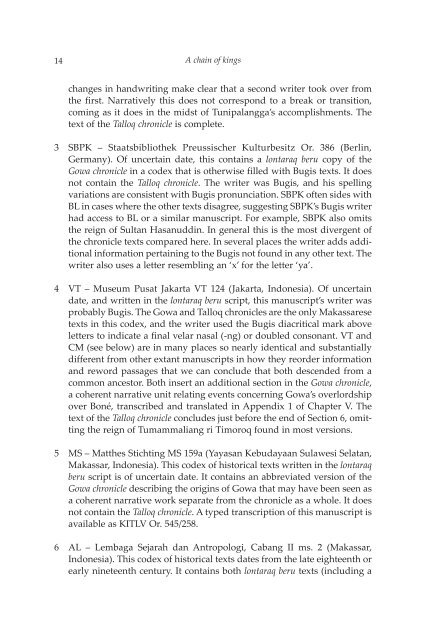A CHAIN OF KINGS - Books and Journals
A CHAIN OF KINGS - Books and Journals
A CHAIN OF KINGS - Books and Journals
Create successful ePaper yourself
Turn your PDF publications into a flip-book with our unique Google optimized e-Paper software.
14<br />
A chain of kings<br />
changes in h<strong>and</strong>writing make clear that a second writer took over from<br />
the first. Narratively this does not correspond to a break or transition,<br />
coming as it does in the midst of Tunipalangga’s accomplishments. The<br />
text of the Talloq chronicle is complete.<br />
3 SBPK ‒ Staatsbibliothek Preussischer Kulturbesitz Or. 386 (Berlin,<br />
Germany). Of uncertain date, this contains a lontaraq beru copy of the<br />
Gowa chronicle in a codex that is otherwise filled with Bugis texts. It does<br />
not contain the Talloq chronicle. The writer was Bugis, <strong>and</strong> his spelling<br />
variations are consistent with Bugis pronunciation. SBPK often sides with<br />
BL in cases where the other texts disagree, suggesting SBPK’s Bugis writer<br />
had access to BL or a similar manuscript. For example, SBPK also omits<br />
the reign of Sultan Hasanuddin. In general this is the most divergent of<br />
the chronicle texts compared here. In several places the writer adds additional<br />
information pertaining to the Bugis not found in any other text. The<br />
writer also uses a letter resembling an ‘x’ for the letter ‘ya’.<br />
4 VT ‒ Museum Pusat Jakarta VT 124 (Jakarta, Indonesia). Of uncertain<br />
date, <strong>and</strong> written in the lontaraq beru script, this manuscript’s writer was<br />
probably Bugis. The Gowa <strong>and</strong> Talloq chronicles are the only Makassarese<br />
texts in this codex, <strong>and</strong> the writer used the Bugis diacritical mark above<br />
letters to indicate a final velar nasal (-ng) or doubled consonant. VT <strong>and</strong><br />
CM (see below) are in many places so nearly identical <strong>and</strong> substantially<br />
different from other extant manuscripts in how they reorder information<br />
<strong>and</strong> reword passages that we can conclude that both descended from a<br />
common ancestor. Both insert an additional section in the Gowa chronicle,<br />
a coherent narrative unit relating events concerning Gowa’s overlordship<br />
over Boné, transcribed <strong>and</strong> translated in Appendix 1 of Chapter V. The<br />
text of the Talloq chronicle concludes just before the end of Section 6, omitting<br />
the reign of Tumammaliang ri Timoroq found in most versions.<br />
5 MS ‒ Matthes Stichting MS 159a (Yayasan Kebudayaan Sulawesi Selatan,<br />
Makassar, Indonesia). This codex of historical texts written in the lontaraq<br />
beru script is of uncertain date. It contains an abbreviated version of the<br />
Gowa chronicle describing the origins of Gowa that may have been seen as<br />
a coherent narrative work separate from the chronicle as a whole. It does<br />
not contain the Talloq chronicle. A typed transcription of this manuscript is<br />
available as KITLV Or. 545/258.<br />
6 AL ‒ Lembaga Sejarah dan Antropologi, Cabang II ms. 2 (Makassar,<br />
Indonesia). This codex of historical texts dates from the late eighteenth or<br />
early nineteenth century. It contains both lontaraq beru texts (including a









![Am HaSefer [Volk des Buches] - Books and Journals](https://img.yumpu.com/20648352/1/174x260/am-hasefer-volk-des-buches-books-and-journals.jpg?quality=85)







